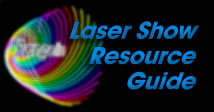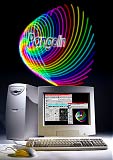|



|
 |
System components
|
| |
|
|


 |
|
|
|
The first requirement for a laser
show is, of course, a laser. There are three general types of light show graphics lasers:
solid-state lasers such as diode and DPSS lasers (red, green,
blue), low power helium-neon (red, orange, yellow, green), and argon (green-blue) or mixed gas
argon/krypton (red-yellow-green-blue) lasers. Solid-state lasers are
available in power levels ranging from a few milliwatts to tens of
watts. Helium-Neon lasers are available in power levels ranging
from a few milliwatts to tens of milliwatts. And Argon or
Argon/Krypton lasers are available in power levels ranging from
tens of milliwatts up to tens of watts. The power you need depends on whether you're concentrating
on beams or graphics, and on the scope of your shows -- for small or large audiences.
Low power lasers (such as those lasers up to
250 milliwatts) are fine for studio work and
small-scale indoor graphics. These lasers tend to use standard 120 volt AC power and are
air-cooled by fans. They can handle many indoor graphics, and small-scale indoor beam
effects. High power lasers (such as those lasers over 250 milliwatts) may
need more AC power and require water cooling using hoses or
chillers, especially Argon and Argon/Krypton types. They are for large-scale indoor graphics, outdoor graphics and beam effects.
Usually, a laser projector will work with just about any
laser. Therefore, if your emphasis is on graphics, spend less on the laser initially and
more on the projector and computer system. This is because you can later rent or purchase
a more powerful laser for your existing projector.
If your emphasis is on beam effects, spend more on the
laser to get the maximum possible brightness. You want as much power as possible so beams
show up even under adverse conditions, such as outdoor shows in high-brightness areas.
A popular laser for outdoor overhead beam
effects is a Q-switched solid-state laser based on frequency-doubled YAG technology.
This type of Q-switched YAG laser is great for overhead beams, but are poorly suited for graphics as they have
larger diameters and usually are not continuous. (Scanned graphics will have fat, dotted
lines.) If you are buying only one laser for both graphics and beams, stick with
continuous-wave gas laser technology such as argon/krypton.
You can purchase new or used lasers. Probably the best
value is a small RGB solid-state laser that uses a diode laser for red and
blue, and DPSS laser for green. These are available from reputable laser dealers.
|
|
The laser projector includes a
pair of galvanometer scanners, a blanking or color system, and related electronics. You
can either buy a fully assembled laser projector, or put together your own projector.
Fully assembled projectors are usually made on a
semi-custom basis. The manufacturer will design a system with components matched for your
particular requirements. Full-color graphics projectors start at around
$2500. Adding beam tables and lumia effects quickly raises the cost.
If you are technically minded, you can buy the projector
components and assemble them into a system. This is an especially attractive approach for
those on a budget with relatively simple needs, or for those who have previous experience
with laser projectors.
Most of the projector companies in this Guide
provide parts and subassemblies, as well as complete projectors. They would be pleased to
give you advice keyed to your technical background.
Before going into detail on the projector parts, let's
look at the final components of a laser system: the computer and software.
|
|
Laser show
software is available for almost every personal computer, from the Amiga and Macintosh to
Windows-compatible PC compatibles. There are even programs with their own custom computers. Look for the
software first; this will help narrow down your choice of computer.
There are three general levels of software: hobbyist,
intermediate and professional. Roughly speaking, price ranges are around
$500 for the
hobbyist level, $1000-3500 for intermediate, and $5000 and above for professional. This may
seem costly in comparison with spreadsheets or word processors. But remember that the
market for laser show programs is much more limited.
As with all software, the more expensive programs give you
more features, a friendlier user interface and better service and support. Be sure to
choose software that meets your needs, both for now and for the future.
|

 |
|
Pangolin's Lasershow Designer
2000 series is intended for laser professionals -- those who create shows for a
living. LD2000 incorporates advanced features within an easy-to-use interface.
LD2000 comes with its own "laser computer", the QM2000 board. This features a
Motorola ColdFire microprocessor with up to 512 MB of memory.
Pangolin's Lasershow Designer
QuickShow series is intended for casual laser users --
those who do laser shows in discos, clubs, churches, or even
in their own home. QuickShow comes with it's own laser
hardware which is USB-based, so it is very easy to use with a
laptop computer.
With LD2000 as well as QuickShow, you
can use any Windows-compatible computer. We recommend a fast Pentium-class computer, but you
can use older or slower computers. It should have Level 2 Multimedia with CD-ROM and a
sound card. The software is distributed on CD- or DVD-ROM.
LD2000 runs under Windows 2000, Windows XP, Windows VISTA
or Windows 7. There are three versions:
LD2000 Professional, LD2000 Basic
and LD2000 Intro. (Pangolin has separate information which discuss these programs
in detail.) QuickShow runs under Windows XP, Windows VISTA or Windows
7.
All Pangolin software is designed to run any type of laser projector, to
give you the most flexibility.
|
|
|
|
This page last updated:
Wednesday, Januari 29, 2020
| |
|

